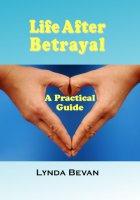Life After Betrayal: A Practical Guide

Betrayal by a long-term partner is a painful business. Choosing to try to heal and continue a relationship after such a betrayal is very challenging. In her book, Life After Betrayal: A Practical Guide, author Linda Bevan provides a guide for couples who do choose to stay together after a serious betrayal. Pitching itself as “an honest, straightforward book that helps the reader though each step on the road to recovery,” it’s a slim volume, less than 100 pages, and easily accessible with its big type and many bulleted lists.
For anyone who hasn’t been in therapy, browsed the self-help section of the bookstore, or watched The Dr. Phil Show, it may introduce some basic psychological concepts - such as boundaries and self-esteem - and offer some insights into how to recreate trust in a partnership. Overall, however, the book is poorly organized, and, at times, painfully condescending. I found the author’s insistence on referring to the mind as “our memory box” when she explains how childhood experiences inform adult behaviours particularly annoying.
In many cases her “step-by-step” guide felt like nothing more than a series of brainstormed lists with little practical advice as to how wronged partners might actually cope or heal themselves and their off-the-rails relationships. In some cases, she just gives bad advice. For example, in Step Eight, “Managing Jealousy and Control,” we are told: “In moving on, trust is the part of the relationship that must come before anything else. If you cannot trust your partner then you have to face the possibility that the relationship will end.” True, indeed. However, rather than validating the betrayed partner’s feelings of insecurity and putting the onus on the one who did the betraying to re-establish trust, the author suggests that the betrayed partner make a leap of faith and simply trust. Your best friend or, in fact, any stranger on the bus will tell you otherwise.
Finally, though the author gives a quick nod to same-sex relationships, potential readers should note that the book uses exclusively heterosexual examples and appears aimed at a heterosexual (female) audience. While this is not the only self-help book that assumes a heterosexual female readership, I suspect that there are other publications that are more helpful for anyone who’s trying to heal a relationship after betrayal.